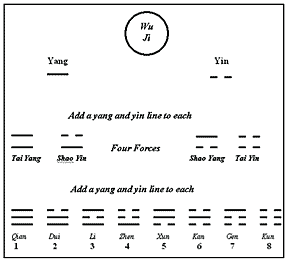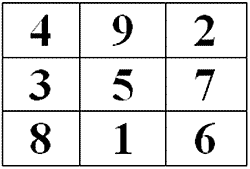This article is the first of a three-part series on the Eight Extraordinary Channels and Taoist cosmology.
One of the most interesting aspects of Chinese medicine and qi gong is the Eight Extraordinary Channels, which is considered the most constitutional of the acupuncture channel network.
The classic parings are the chong-yin wei, du-yang qiao, ren-yin qiao, and dai-yang wei channels.
The He Tu and Luo Shu diagrams are two foundational models of the eight branches of Tao; He Tu is considered the oldest of the Taoist cosmological diagrams and the origin of the Luo Shu. These two cosmological diagrams reveal an energetic unfolding pattern of the Eight Extraordinary Channels and the origin of "coupled pairs."
The theoretical basis supporting the classic Eight Extraordinary Channel pairs begins with Taoist cosmology. The following presents a brief summary of this cosmological-energetic view. Refer to my previous articles on I Ching acupuncture for background information.

The above pattern is the Early Heaven ba gua (xian tian). The Chinese refer to each three-line formation as a gua. It is also called a trigram. This eight-trigram formation is an energy formation, which can be applied to a variety of universal patterns. The following presentation unites the Eight Extraordinary Channels and the Early Heaven energy pattern.
A. Wu ji represents the original or primordial force of life; in numerology, it is number 1. From an Eight Extraordinary Channel perspective, it corresponds to the chong mai channel, which is the yuan, primordial or source channel. It is also referred to as the sea of the 12 primary channels.
B. Yin-yang is derived from the wu ji. Inn numerology, it is number 2. From an Eight Extraordinary Channel perspective, it corresponds to the du and rendu is the sea of yang, and the ren is the sea of yin.
C. Four forces is derived from the interaction of yin-yang: tai yang, shao yin, tai yin and shao yang. In numerology, it is number 4. From an Eight Extraordinary Channel perspective, the four forces correspond to the four sea channels - the chong, du, ren and dai channels. The dai mai is referred to as the sea of ming men.
D. Ba gua is derived from the interaction of the four forces of yin-yang. In numerology, it is number 8. From an Eight Extraordinary Channel perspective, they correspond to the chong, du, ren, dai, yin-yang qiao and yin-yang wei channels. The qiao and wei channels are referred to as the four transporter channels.
Luo Shu : Nine Palaces
Legend has it that in the Xia dynasty, Yu the Great was rewarded by Heaven for his many positive contributions to humanity. Out of the river a horse-dragon appeared with special markings on its back. Those marks are the Luo Shu. The Luo Shu has many applications in the Taoist arts; for example, flying stars feng shui, meridian clock theory, nine star astrology and nei dan-internal alchemy.


The three diagrams presented above are versions of the Luo Shu, which is commonly known as the Magic Square. The numbers include 1-9 in modern versions and dots in ancient versions.
Adding three numbers in any direction equals 15, representing balance. Five in the center is the earth element. It is the core, yuan, center or primordial condition, and all aspects of life originate from the center.
The Luo Shu has a number pattern. Follow the ascending order of the numbers, and the pattern is revealed. Patterns originate in the center (5) and flow or fly around the Nine Palaces from six through four. We can place universal correspondences into this special pattern. The items placed in this pattern can change, but the pattern sequence is fixed.
Numbers correspond to the eight trigrams. Please see the following Luo Shu.
Luo Shu Application
The traditional acupuncture meridian clock is often presented without a theory supporting its cyclic pattern. The Luo Shu and eight trigrams provide theoretical support to this ancient model.
| 4 - - - | 9 - - - | 2 - - |
| 3 - - | 5 Center Earth | 7 - - |
| 8 - - | 1 - - | 6 - - |
even numbers are yin. Note that each palace contains
a number, trigram, element and associated organ-channel.
Meridian Clock
- The center is the beginning position and contains the earth element. In ba gua theory there are eight directions, not nine. There is no trigram for the center.
- Numbers in the Luo Shu relate to trigrams and their corresponding five elements and channel(s). Place the channel into its related element and palace. The following pattern is the cyclic flow of organ-channels and Luo Shu palaces.
- Originating in the center (5), we fly from palace to palace in ascending order; for example, from 5 move to palace number 6, then 7, 8, 9, 1, 2, 3, and 4.
- The following is the exact pattern:
A. 6 (Qian) is yin Metal and the lung.
B. 7 (Dui) is yang Metal and the large intestine.
C. 8 (Gen) is Earth and the stomach-spleen.
D. 9 (Li) is Fire and the heart-small intestine.
E. 1 (Kan) is Water and the bladder-kidney.
F. 2 (Kun) is Earth/Fire and the pericardium-san jiao.
G. 3 (Zhen) is yang Wood and the gallbladder.
H. 4 (Xun) is yin Wood and the liver.
This pattern of Luo Shu reveals the meridian clock cycle. The Eight Extraordinary Channels will also be placed in this pattern, which is integral in revealing the classic Eight Extraordinary Channel pairings.
Part two of this series will introduce the He Tu, which contains the theory and application of "coupled pairs."
Click here for previous articles by David Twicken, DOM, LAc.




